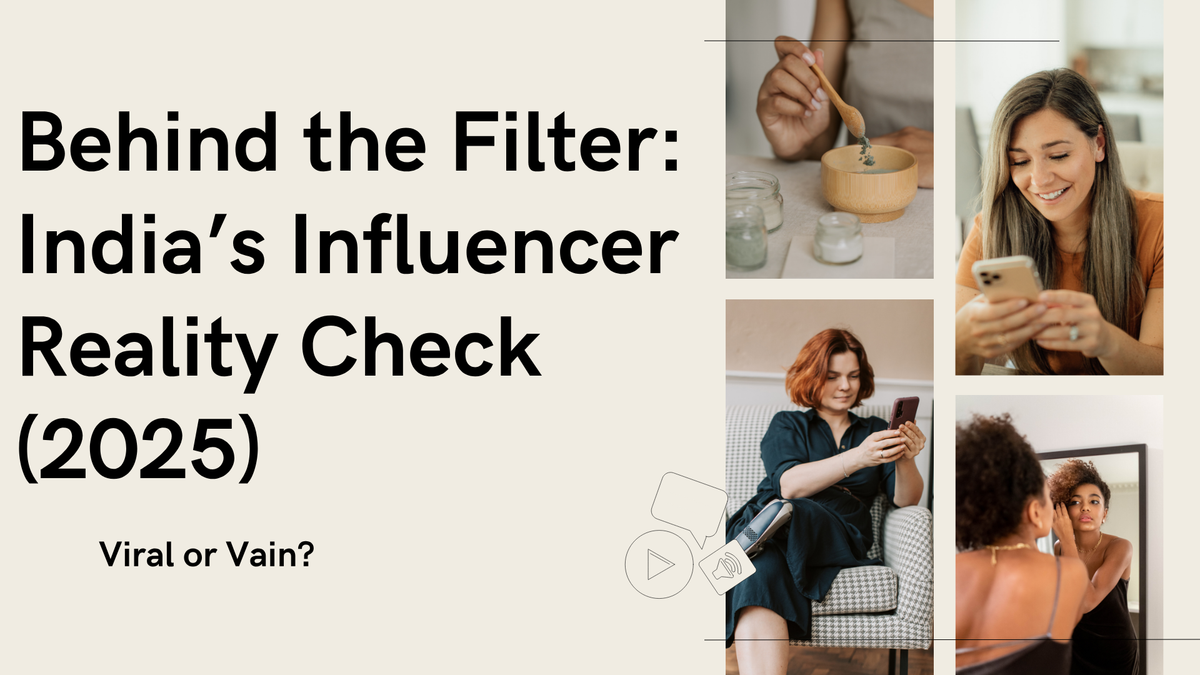Viral or Vain? India's Rising Influencer Economy and the Truth Behind the Likes
India’s influencer boom: viral fame or hollow validation? Explore the 25% market growth, mental-health strain, and evolving footprint of creators from virtual Kyra to Prajakta Koli in a revealing look beyond the likes.

The India influencer 2025 space is on fire now a billion-dollar market in ad spend, brand collaborations, and social approval. But underlying the filtered images and motivational hashtags exists a messy reality: new digital content tax legislation, endemic creator exhaustion, controversial brand relationships, and a war of fake followers. Let's take this manic universe apart and question: are influencers really transforming culture or simply pursuing vanity?
1. The Explosion of India's Creator Economy
India's creator economy has registered meteoric rise in the last few years:
- India had millions of active creators on YouTube, Instagram, and local platforms as of 2022, earning revenue streams from ad shares, affiliate links, brand collaborations, and merchandise. (lawfluencers.com)
- The Income Tax Bill 2025 has brought such creators under the tax umbrella, dubbing perks, barter transactions, and freebies as taxable income. (taxconcept.net)
- Moreover, brands are subject to a 10% TDS on brand transactions over ₹30,000 ($360) even on non-monetary presents subject to clear disclosure
This regulatory thrust mirrors the growing importance of digital media as a legitimate business, even as it strikes fear in the hearts of budding creators.
2. Taxing the Likes: New Digital Content Tax Regime
A. Tax Treatment of Gifts, Barter, and Sponsorships
Under Section 194R, any consideration from brand collabs worth more than ₹20,000 a year becomes taxable. These could be smartphones, holidays, apparel, or special services
- Brands are required to withhold 10% TDS on these benefits.
- Such non-cash inflows must be declared by influencers as business income—permitted to expense related expenses
This clampdown represents a change from amateurish content production towards professionalized income, compelling creators to use accounting systems and legal compliance.
B. GST Requirements and Compliance Specifications
Creators who earn more than ₹20 lakh (₹10 lakh in special states) now require GST registration and will have to count any ad income, affiliate commission, and sponsored content as part of taxable turnover (financesxpress.com.)
While the reforms bring increased revenue transparency, they also burden micro-influencers with a greater compliance requirement, many being solo operators.
C. Digital Surveillance & Privacy Implications
The new Income Tax Bill 2025 also allows tax inspectors to access social media, emails, cloud storage, and smartphones during audits
This raises serious privacy issues: influencers whose posts are by definition public could be subject to invasive scrutiny of their personal communications and business records, triggering a backlash from the creator community.
3. Behind-the-Scenes Realities: Burnout & Brand Conflicts
A. The High-Stress Reality of Creator Burnout
In the race for attention and relevance, many Indian creators are burning out:
- A Times of India feature highlighted the tragic suicide of 24-year-old Misha Agarwal, who linked declining followers to “worthlessness”
- Globally, creators like Jayde Powell report constant migraines, anxiety, and reliance on therapy services like CreatorCare underscoring the mental health toll of perpetual content creation. (wired.com)
Creators face unsustainable demands: producing daily content, meeting shifting algorithm metrics, and enduring public scrutiny—often without institutional support or health benefits.
B. Brand Partnership Pitfalls
Influencer-brand collaboration seems lucrative but it’s rife with friction:
- A recent survey by Hash Fame found that ₹350 crore (~$42M) in brand deals fell through due to fake or unscrupulous talent managers
- Deals can be murky; non-monetary payments frequently undercompensated; and payments often late—some creators rely on Creators Guild of America-type riders to get timely pay
These variable partnerships reflect a lack of formalism in the creator-brand economy professionalism is all the more important.
4. Fake Followers & Fraud: Inflating Influence
Inflating Influence, Undermining Trust
Even as numbers boom, India's influencer market is fighting a plague of fake followers and inflated engagement. Brands are losing more and more money on campaigns that are based on phony metrics, while honest creators are fighting to get seen. Sophisticated bots and illicit growth services are manipulating the system, making it increasingly difficult for honest influencers to compete. As trust wanes, platforms and agencies are demanding real-time reporting, AI-driven audits, and stricter punishment for fraud. If left unaddressed, artificial follower trends have the potential to destroy the credibility of the entire India influencer 2025 ecosystem.
A. The Fake-Follower Epidemic
Credibility is weak in the influencer economy. Bogus engagements are widespread:
- Reports put over 60% of the followers of influencers in India as being fake
- Klug Klug audit discovered just 2.48 million genuine accounts from 8 million influencers audited
This inflation not just misleads brands but dismantles trust signal for an impending crisis for the India influencer 2025 space.
B. Tools and Tactics Against False Reach
Brands and platforms are now looking towards analytics to identify "crowdturfing," bot registrations, and uneven engagement patterns
- MIT-style academic tools can mark suspicious usernames, interactions, and bot-like groupings.
- Agencies increasingly screen influencers through manual auditing and third-party sites.
Influencers who construct authentic communities can now possess a strategic advantage in authenticity and engagement.
5. Sustainability vs. Oversaturation: The Creator Crunch
A. Market Oversaturation
With millions vying for scarce attention, the threshold for creative differentiation has risen exponentially. (en.wikipedia.org.)
In order to survive, creators need to niche down, invest in more in-depth engagement, diversify monetization (i.e., merch, Patreon), and safeguard their IP.
B. Ageism & Generational Pressures
Age 30-40 creators feel they can't keep up with fast-changing platforms like TikTok, while Gen Z creators demand ephemeral attention spans.
- Several older creators are moving into consulting, brand strategy, or product positions as a way to help careers endure.
C. The Reality of "Real Jobs"
Glamorous reputations aside, the profession is precarious:
- In America, there are 27 million creators but just 12 million actually report full-time income
- India's creator base is likewise divided some make it, others must stay fringe or moonlight to keep income.
This contradiction reveals the fundamental tension between the cultural power of creators and the economic vulnerability of their living.
6. Toward a More Equitable Creator Ecosystem
A. Professionalization & Standard Contracts
The rise of creators' unions and rider contracts (such as Creators Guild of America) indicates the existence of formalized standards facilitating timely payments, contract transparency, and intellectual property rights
Brands and agencies are starting to implement these measures to promote trust and reliability.
B. Financial & Mental Health Support
Services such as CreatorCare reflect the necessity of having mental health support in the system accessible (wired.com)
At the same time, new influencer tax manuals (e.g., Advance Tax FAQs, GST advice) seek to assist creators in navigating TDS, presumptive taxation (Section 44ADA), and accounting
C. Authenticity as Currency
Real influencers with organic niche audiences micro and nano influencers are gaining more value as follower inflation declines. Brands increasingly want authentic engagement and open partnerships propelling the industry toward more realistic ROI and sustainable influence.
7. What Lies Ahead for India Influencer 2025
A. Stricter Regulation & Enforcement
Anticipate more regulatory clarity as digital earnings are taxed. Anticipate platforms to report information to tax authorities and more vigorous TDS enforcement with audits and fines on the rise.
B. Industry Norms & Infrastructure
Professional associations and community-driven groups (such as the Creators Guild) will establish standards around deals, ethics, and ownership of content.
C. Mental Health & Career Transition Support
Mental wellness programs and structural transition models for burnout-affected creators will be standard and expected.
Conclusion: Viral or Vain?
The India influencer 2025 space is at a crossroads: it has gone mainstream but not without growing pains. Rising tax burdens, mental health pressures, brand misalignment, follower fraud, and inconsistent monetization threaten to destabilize the ecosystem.
But the evolution is inspiring too. With formalized frameworks, mental health care, anti-fraud technology, and authenticity-centered strategies, this remains a revolutionary cultural moment one that can create strong, expressive, and effective digital creators.
Do you represent an influencer, brand, or digital storyteller charting this new landscape?
Subscribe to Allegedly News Network for investigative deep-dives, legal deconstructions, mental health analysis, and strategic guides specific to India's creator frontier.
Subscribe now and be part of the movement towards a prosperous, ethical, and future-facing creator economy India.




